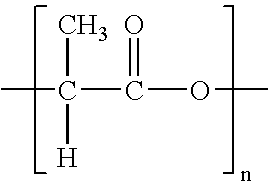Biodegradable compounds including poly(lactic acid) polymer compositions and products
a technology of biodegradable compounds and polymers, applied in the direction of dyeing process, microcapsules, capsule delivery, etc., can solve the problems of unaffordability for consumers, cumbersome and expensive production of these polymers, and the amount of litter produced each day, so as to improve flexibility and ductility.
- Summary
- Abstract
- Description
- Claims
- Application Information
AI Technical Summary
Benefits of technology
Problems solved by technology
Method used
Image
Examples
example 1
Injection Molding Formulation I
[0049] An injection molding formulation is prepared which comprises [0050] 94% by weight poly(lactic acid) polymer [0051] 5% by weight (co-polyester polymer with adipic acid) [0052] 1% by weight Zinc stearate
[0053] The above-mentioned compounds are mixed by means of extrusion compounding at a temperature of 160° C. during about 2 to 10 minutes Then, the resulting mixture is filled in a injection molding device at a temperature of about 160° C. and is injected into a mold at a temperature of about 20° C. in order to obtain an injection molded cup.
example 2
Injection Molding Formulation H
[0054] An injection molding formulation is prepared which comprises [0055] 74.5% by weight poly (lactic acid) polymer [0056] 5% by weight (co-polyester polymer with adipic acid) [0057] 20% by weight of magnesium silicate [0058] 0.5% by weight of 2,5-Dimethyl-2,5-di(t-butyl peroxy) hexane
[0059] The injection molding formulation is prepared as detailed in Example 1 and injection molded products may be obtained according to the steps lined out in said Example 1.
example 3
[0060] Blown Film Extrusion Formulation
[0061] A blown film extrusion formulation is prepared which comprises [0062] 55% by weight poly (lactic acid) polymer 0 to 15% by weight (co-polyester polymer with adipic acid) [0063] 25% by weight (poly epsilon caprolactone) [0064] 4% by weight of magnesium silicate [0065] 1.0% by weight of 2,5-Dimethyl-2,5-di(t-butyl peroxy) hexane [0066] 15% by weight of tributyl citrate
[0067] The resulting mixture is filled in a blow film extrusion device and a self-supporting film having a thickness of 10 μm-90 μm is obtained which may be used for trash or grocery bags.
PUM
| Property | Measurement | Unit |
|---|---|---|
| Temperature | aaaaa | aaaaa |
| Fraction | aaaaa | aaaaa |
| Fraction | aaaaa | aaaaa |
Abstract
Description
Claims
Application Information
 Login to View More
Login to View More - R&D
- Intellectual Property
- Life Sciences
- Materials
- Tech Scout
- Unparalleled Data Quality
- Higher Quality Content
- 60% Fewer Hallucinations
Browse by: Latest US Patents, China's latest patents, Technical Efficacy Thesaurus, Application Domain, Technology Topic, Popular Technical Reports.
© 2025 PatSnap. All rights reserved.Legal|Privacy policy|Modern Slavery Act Transparency Statement|Sitemap|About US| Contact US: help@patsnap.com

